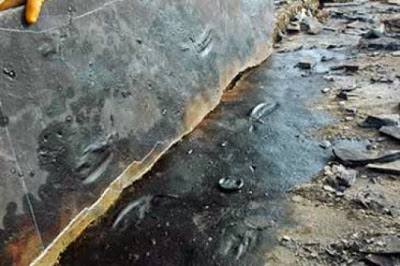
Trackways formed on an ancient seabed have shed new light on how nothosaurs, ancient marine reptiles that lived during the age of the dinosaurs, propelled themselves through water. The evidence is described by a team from Bristol and China in Nature Communications today.
During the Mesozoic, 252-66 million years ago, the seas were ruled by a variety of marine reptiles. One of the earliest groups were the nothosaurs, voracious semi-aquatic hunters with elongate bodies and paddle-like limbs. They were the top predators of the Triassic coasts, some 245 million years ago.
Their mode of swimming has long been debated: did they row themselves along with a back-and-forth motion of their limbs, or did they ‘fly’ underwater, sweeping their forepaddles in a figure-eight motion like a modern penguin?
Scientists from the University of Bristol and colleagues in China studied trackways formed on an ancient seabed which were recently discovered in Yunnan, southwest China. The tracks consist of slots in the mud arranged in pairs, and in long series of ten to fifty that follow straight lines and sweeping curves.
The size and spacing of the paired markings indicate that they were created by the forelimbs of nothosaurs, representing animals ranging in size from over 3 metres to less than a metre in length.
They demonstrate that that these reptiles moved over the seafloor by rowing their forelimbs in unison, the first direct evidence of how these creatures propelled themselves in the water.
Two types of nothosaurs, the large Nothosaurus and the diminutive Lariosaurus, known from complete fossil skeletons from the Triassic of southern China, are the likely trackmakers.
Professor Qiyue Zhang from Chengdu Center of China Geological Survey, leader of the research, said: “We interpret the tracks as foraging trails. The nothosaur was a predator, and this was a smart way to feed. As its paddles scooped out the soft mud, they probably disturbed fishes and shrimps, which it snapped up with needle-sharp teeth.”
The tracks come from localities around Luoping in Yunnan, a well known site of exceptional fossil preservation that has yielded thousands of exquisite fossils of sea creatures, and occasional plants and small terrestrial animals blown in from the nearby islands.
Professor Michael Benton from the University of Bristol, one of the co-authors of the research, said: “When I first saw the site, I couldn’t believe the amazing quality of the fossils. It’s quite unusual to find skeletons of marine reptiles such as the nothosaurs so close to evidence of their tracks.”
Luoping and other sites in South China are shedding light on the recovery of life from the devastating Permo-Triassic mass extinction event which wiped out more than 90 per cent of all species on Earth. Nothosaurs and other marine reptiles were new members of the recovering ecosystems.
Co-author Professor Shixue Hu, also from Chengdu Center of China Geological Survey, said: “Here we see a detailed snapshot of how life was within 8 million years of the mass extinction. It took all that time for Earth to settle down from the cataclysm, and the arrival of these large, complex marine predators shows us the ecosystems had finally rebuilt themselves, and life could be said to have recovered from the crisis.”
Journal Reference:
Qiyue Zhang, Wen Wen, Shixue Hu, Michael J. Benton, Changyong Zhou, Tao Xie, Tao Lü, Jinyuan Huang, Brian Choo, Zhong-Qiang Chen, Jun Liu, Qican Zhang. Nothosaur foraging tracks from the Middle Triassic of southwestern China. Nature Communications, 2014; 5 DOI: 10.1038/ncomms4973
Note : The above story is based on materials provided by University of Bristol.










